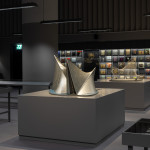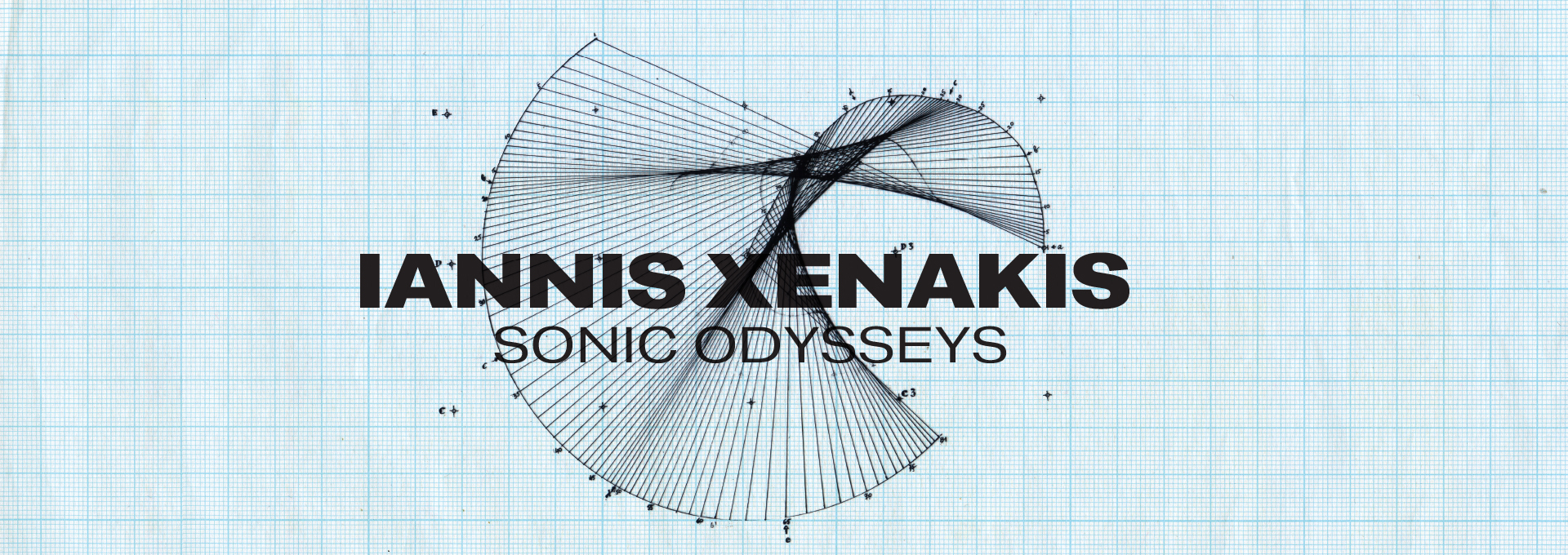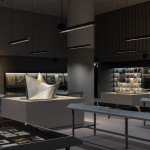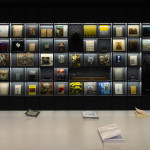EMΣΤ is pleased to present the first major comprehensive exhibition in Greece of Iannis Xenakis (1922-2001), the avant-garde composer, music theorist, architect, engineer, mathematician, and one of the most progressive creative thinkers and cultural practitioners of the second half of the 20th century. In the 1950s, Xenakis broke the boundaries of contemporary music and devised a genre of music that is entirely unique. Instantly recognisable despite being in a state of constant reinvention and revolution, his radical music is, in essence, a reference to antiquity, an ode to nature and the elements, a tribute to modernism at its most extreme, and is visionary in its use of technology. Though widely acclaimed internationally, his work has yet to be presented in such an extensive way to date in Greece, and this exhibition represents the most extensive presentation of the work of this avant-garde composer, architect and mathematician, both in Greece and internationally.
The initiative for the Xenakis exhibition is in line with one of the museum’s missions, which is, among other things, to highlight the work of prominent or even lesser known but significant cultural practitioners of the Greek diaspora.
Xenakis pioneered the use of mathematical models in music such as the application of game theory, he was – and still remains – a seminal influence on the development of electronic and industrial music, and one of the innovators of multi-media art. He conjoined music with architecture, creating music for pre-existing spaces but also designing spaces for specific music compositions and performances, reconfiguring the classical spatial arrangement of the orchestra. He was also one of the first to deploy computers for musical composition. The exhibition highlights the multi-faceted, multidisciplinary practice of this singular figure – a true polymath – and illuminates the breadth of his prolific oeuvre demonstrating just how far ahead of his time he was, so unprecedented was his vision.
In 1947, during the Civil War and after receiving his degree in engineering from the Athens Polytechnic, Xenakis fled to Paris as a wanted-man for his resistance activities, only to return 27 years later after the fall of the military dictatorship in 1974, and receiving an official pardon after nearly 3 decades of self-imposed exile. Until his death in 2001 he composed over 150 works – from vocal, choral and orchestral, to chamber and solo music for piano, strings and percussion – as well as electronic music written on the UPIC, a computerised musical composition tool he devised that could translate graphical images into musical results. Xenakis also left behind a small but seminal architectural oeuvre, produced while working with Le Corbusier at the latter’s studio in Paris in the 1950s. Most emblematic of these is the Philips Pavilion which Le Corbusier charged him with, for the Brussels World’s Fair Expo 1958, with music by Edgar Varèse (his Poème Electronique), while at the entrance to the Pavilion Xenakis’ own composition Concret PH, could be heard. The exhibition includes the original model of the architectural structure.
Co-produced by ΕΜΣΤ and the Philharmonie de Paris, the exhibition focuses on the most important and ground-breaking work of Xenakis’s visual, literary, architectural, and musical output, while illuminating his personal history by contextualising the composer in his times, and the political and cultural movements that defined him as an artist. Based on the Xenakis Family archives, the exhibition parcours is designed around six chapters, centred on a number of major works, both musical and architectural. Presenting both personal and artistic material, a thematic and chronological narrative thread highlights his rich, expansive artistic vision, invites the visitor to gain insight into his tumultuous personal history, reveals the multitude of his ecumenical interests through the recreation of his library, and takes us on a journey of Xenakis’s unique universe as we discover his sweeping sound masses and ultra-modern multi-dimensional spatial and musical universes.
The exhibition is organised around six chapters, focusing on some of Xenakis’ most seminal works, both musical and architectural. A narrative thread, both thematic and chronological, invites the visitor to absorb Xenakis’ unique world through both sight and sound. The exhibition includes 20 musical and architectural opuses, 220 original and archival documents: photos, models, scores and personal items as well as a number of audio-visual works.
Curators: Mâkhi Xenakis, Thierry Maniguet, Katerina Gregos
EXHIBITION PARCOURS
1. THE FIRST YEARS
In presenting a number of objects from Xenakis’ personal collection, the exhibition provides insight into how the composer worked as well as his musical, literary, and visual references, including his interest in ancient Greek, Pre-Columbian, African, and Asian cultures. Also apparent is another major source of inspiration, nature, in the form of scores, artworks, or personal photographs. Several of Xenakis’ musical pieces, including Aïs, a painful echo of the premature death of his mother, Fotini, or O-Mega, his last opus, are shown alongside works borrowed from museum collections, images of which accompanied him throughout his life.
These objects also tell the story of his birth and childhood in Romania, his school years spent at the boarding school on the island of Spetses, the resistance during the Second World War, up to the wound that would mark him for life, followed by his exile and the death sentence he received in absentia. All of these contributed to the formation of the Xenakian language.
2. PHILIPS PAVILION
The visitor is invited to (re)discover the emblematic Philips Pavilion, Xenakis’ first seminal architectural work, and his interrelated orchestral composition for 61 instruments, Metastasis, considered his first mature work, both of which are rooted in mathematics and signal the beginning of Xenakis’ artistic recognition. In addition, archival documents illustrate his encounters with Le Corbusier, Edgar Varèse, and Olivier Messiaen. Together with the Pavilion’s model, an immersive display alludes to the 1958 show, designed around images of Le Corbusier and the music of Varèse, alternating with Xenakis’ electronic piece, Concret PH, which was played at the entrance. The Pavilion consisted of nine hyperbolic paraboloids instead of flat surfaces and can be considered a precursor of “parametric architecture”, whereby geometric forms are designed by computers to produce complex architectural designs. The Philips Pavilion was one of the earliest so-called “multi-media” works.
3. ALLOYS
Engineer, architect, composer, mathematician, and computer expert, Xenakis was neither one of these exclusively, nor the other. Advocating for alliances between arts and sciences, his musical and architectural work is the reflection of these different disciplines, reinforced by complementary dynamics. This chapter brings into perspective his relationship with German conductor Hermann Scherchen, who contributed to his public recognition, and juxtaposes his great architectural projects with the stochastic music compositions, such as the undulating glass panels of the Couvent Sainte-Marie de La Tourette, which echo the musical matrixes of Achorripsis or Pithoprakta.
4. POLYTOPES
The Polytopes – the multi-media spatial works that conjoined sound, light, and live performances – are an encapsulation of Xenakis’ interests and skills, as they combine all of these. Considered part of his mature oeuvre, the Polytopes are a synthesis of Xenakian thought. From the French pavilion at the Montreal Exhibition in 1967, to the Mycenae Polytope or the Beaubourg Diatope, both produced in 1978, these ambitious, complex projects enabled Xenakis to reach a wider audience, who came to witness these spatialised shows that mixed electronic or instrumental sound with light installations. This section brings together architectural drawings, archive pieces, and photographs that shed light on these emblematic works which are precursors of New Media Art or digital art today.
5. SPACE – TIME
If the description of Xenakis’ practice as being “in-time” and simultaneously “outside-time” refers to the understanding of musical time in the form of a succession of sound events or autonomous time-related segments, this notion also contains a spatial vision of the time-related sequence. Likewise, several works presented in this section radically question sound spatialisation, whether by placing the person listening within the orchestra itself like, for example, Terretektorh, created in 1966 for the Royan International Contemporary Art Festival, or Hibiki Hana-Ma, which was composed in 1970 for the Tokyo Universal Exhibition and employed a complex system of speakers.
6. MACHINE AND DRAWING
The final chapter of the exhibition presents Xenakis’ exploration of machines and computing, an integral part of his eternal quest for the perfect tool that can both perform complex calculations and grasp the graphic representation of sound phenomena. Most emblematic of these is the UPIC synthesizer, which he created at the CEMAMu (Centre d’Etudes de Mathématique et Automatique Musicales), the computer music centre founded by Xenakis in Paris in 1972 in collaboration with academics from several disciplines, including aesthetics, mathematics, computer science, philosophy, and electrical engineering. The documents and archives in this section highlight the composer’s decisive contribution to electronic sound synthesis.
EXHIBITION DESIGN
The architecture/exhibition design conceived by Flux Office, Athens (Eva Manidaki and Thanassis Demiris) takes its inspiration from the workshop environment of architectural offices, recording studios and music rehearsal spaces of Xenakis’ time.
The design of the exhibition creates a space for visitors to experience Xenakis’s work in a way that provides insight into his multi-dimensional personality. As a viewer, one has the experience of entering a space of production and creation. Original documents and items are arranged and presented on slanted surfaces that bring to mind architectural designs and the UPIC, the computerised compositional system designed by Xenakis.
The exhibition space is structured around four columns that create an internal subspace containing display cases with Xenakis’s archive and architectural props. Laboratory-style lighting fixtures that are arranged crosswise form a horizon above the showcases. The vertical pedestals form additional subspaces with sound-absorbing material that house Xenakis’s sound events.
An office space, diametrically opposite the entrance and in dialogue with the exhibits, allows visitors to engage with reference material. An archive-library has also been designed in the same section which includes the entire contents of Xenakis’ library; books, records, objects and musical instruments from his personal collection.
Xenakis was an insatiable experimenter, a man responsible for a multidimensional universe that the exhibition’s scenography aims to recognise. In parallel to Xenakis’ great architectural productions, the space setting of the exhibition places Xenakis’ music at its centre, with a number of audio-visual displays, providing insight into the artist’s profuse catalogue as well as an audio soundtrack that plays in the space at regular intervals during the day.
1/ INTIMATE PANTHEON
In presenting a number of objects from Xenakis’ personal collection, the exhibition provides insight into how the composer worked as well as his musical, literary and visual references, including his interest in ancient Greek, Pre-Columbian, African and Asian culture. Also apparent is another major source of inspiration, nature, in the form of scores, artworks or personal photographs. Several of Xenakis musical pieces, including Aïs, a painful echo of the premature death of Photini, his mother, or O-Mega, his last opus, are shown alongside works borrowed from museum collections, images of which accompanied him throughout his life.
These objects also tell the story of his birth and childhood in Romania, his school years spent at the Island of Spetses boarding school, the resistance during the Second World War, up to the wound that would blind him in one eye and mark him for life, followed by his exile and the death sentence he received in absentia. All of the above contributed to the formation of the Xenakian language
2 / PHILIPS PAVILION
The visitor is invited to (re)discover the emblematic Philips Pavilion, Xenakis’ first seminal architectural work, and his interrelated orchestral composition for 61 instruments Metastasis, considered hist first mature work, both of which are rooted in mathematics and both of which signal the beginning of Xenakis’ artistic recognition; archival documents illustrate his encounters with Le Corbusier, and avant-garde composers Edgar Varèse and Olivier Messiaen. Together with the pavilion’s model, a detailed display alludes to inter-disciplinary elements featured in the 1958 show, including Xenakis’ electronic piece, Concret PH, which was played at the entrance of the Pavilion. Consisting of nine hyperbolic paraboloids instead of flat surfaces, the structure can be considered a precursor of “parametric architecture”, whereby geometric forms are designed by computer to produce complex architectural designs. The Pavilion was one of the earliest so-called “multi-media” works.
3/ AMALGAMS
Engineer, architect, composer, mathematician, and computer expert, Xenakis was neither one after the other, nor one without the other. Advocating for alliances between arts and sciences, his musical and architectural work is the reflection of these different disciplines, reinforced by complementary dynamics. This chapter brings into perspective the relationship with the German conductor Hermann Scherchen, who contributed to his public recognition, and juxtaposes the great architectural projects such as the undulating glass panels of the Couvent Sainte-Marie de la Tourette, and stochastic music compositions which echo the musical matrixes of works like Achorripsis or Pithoprakta.
4/ POLYTOPES
The Polytopes – the multi-media spatial works that conjoined together sound, light, and live performances – are an encapsulation of Xenakis interests and skills. Considered part of his mature oeuvre, the polytopes are a synthesis of Xenakian thought. From the Montréal Polytope, his first, for the French pavilion at the Expo1967, Montréal’s World’s Fair, to the Mycenae Polytope or the Beaubourg Diatope (for the newly inaugurated Centre Pompidou) both produced in 1978, these ambitious, complex projects enabled Xenakis to reach a wider audience, who came to witness these spatialised shows that mixed electronic or instrumental sound with light installations and live performance. This section brings together architectural drawings, archive pieces and photographs that shed light on these emblematic works which are precursors of New Media Art or multi-media art today.
5/ SPACE – TIME
If the description of Xenakis’ practice as being ‘in-time’ and simultaneously ‘outside-time’ refers to understanding of musical time in the form of a succession of sound events or autonomous time-related segments, this notion also contains a spatial vision of the time-related sequence. Likewise, several works presented in this section radically question sound spatialisation, whether by placing the person listening within the orchestra itself like, for example, Terretektorh created in 1966 for the Royan International Contemporary Art Festival, or Persephassa, composed in 1969.
6/ MACHINE AND DRAWING
The final chapter of the exhibition presents Xenakis’ exploration of machines and computing, an integral part of his eternal quest for the perfect tool that can both make complex calculations and grasp the graphic representation of sound phenomena. The presentation of the impressive UPIC machine, which he created at the CEMAMu (Centre d’Études de Mathématique et Automatique Musicales), the computer music research centre founded by Xenakis in 1972 in collaboration with academics from several disciplines including aesthetics, mathematics, computer science, philosophy and electrical engineering. The documents and archives in this section highlight the composer’s decisive contribution to electronic sound synthesis.
CITE DE LA MUSIQUE-PHILHARMONIE DE PARIS / XENAKIS FAMILY ARCHIVES
About the Musée de la Musique | Philharmonie de Paris
The Cité de la Musique – Philharmonie de Paris is a French, national public institution and an innovative cultural complex dedicated to the dissemination, education and transmission of music. The symphonic hall with its unique state-of-the-art acoustics offers an exceptional setting in which to listen to all types of music, from classical to pop, jazz and world music. The Philharmonie is also home to the Musée de la Musique – boasting one of the largest collections of musical instruments in the world, as well as the Orchestre de Paris, and the Philharmonie des Enfants.
Each season, the institution presents some 500 concerts, three temporary exhibitions and a wide range of educational activities. It hosts four orchestras in residence and administers the Démos youth orchestras throughout France. Its mission is to renew and broaden the musical public by promoting equal access for all – adults, young people and families – to different forms of music. The Musée de la Musique’s exhibition department, with its innovative program of exhibitions focusing on dialogues between music and the visual arts, on themes from all musical cultures and periods, actively contributes to the institution’s project.
About the Xenakis Family Archives
The Xenakis Family Archives promotes events, publications and information related to the thought and work of Iannis Xenakis.
IMAGES & PRESS MATERIAL

SPONSORS





